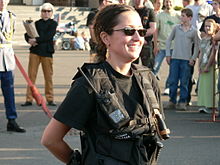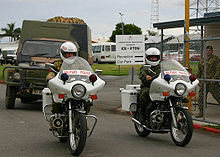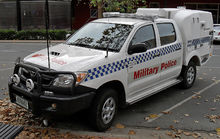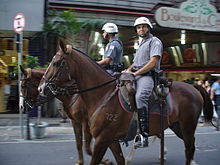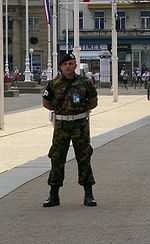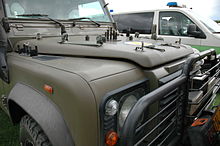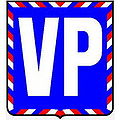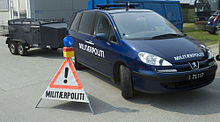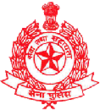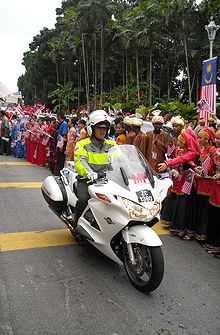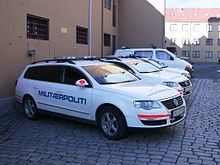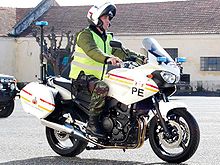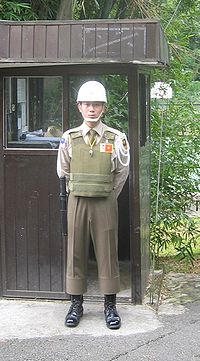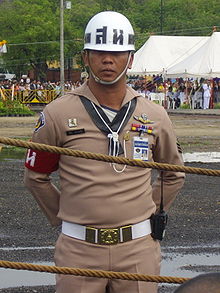- Military police
-
 The Singapore Armed Forces Military Police Command providing security coverage at the Padang in Singapore during the National Day Parade in 2000.
The Singapore Armed Forces Military Police Command providing security coverage at the Padang in Singapore during the National Day Parade in 2000. A Military Police officer of the Armed Forces of the Slovak Republic
A Military Police officer of the Armed Forces of the Slovak Republic
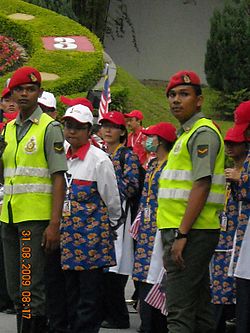 The Malaysian Royal Military Police Corps assisted the Malaysian policemen to providing security coverage at the Parliament Square in Kuala Lumpur during a 52nd Independence Day parade in 2009.
The Malaysian Royal Military Police Corps assisted the Malaysian policemen to providing security coverage at the Parliament Square in Kuala Lumpur during a 52nd Independence Day parade in 2009.
Military police (MP) are police organisations connected with, or part of, the military of a state. The word can have different meanings in different countries, and may refer to:- a section of the military solely responsible for policing the armed forces (referred to as provosts)
- a section of the military responsible for policing in both the armed forces and in the civilian population (most gendarmeries, such as the French Gendarmerie)
- a section of the military solely responsible for policing the civilian population (such as the Romanian Gendarmerie)
- the preventative police forces of each Brazilian state (Policia Militar), responsible for policing the civilian population, which become auxiliary forces of the Brazilian Army in time of war
The status of military police is usually prominently displayed on the helmet and/or on an armband, brassard, or arm or shoulder flash. In the Second World War, the military police of the German Army still used a metal gorget as an emblem.
Naval police are sometimes called "masters-at-arms".
Australia
In the Australian Army, the Royal Australian Corps of Military Police also performs the role of a secondary communications network in the front battle zone. In the Royal Australian Navy, the Naval Police Coxswain Branch performs dual roles of performing general police duties, investigation of criminal offences and a secondary role of ships' coxswain staff responsible for administration of ships' personnel. In the Royal Australian Air Force, the Royal Australian Air Force Security Police perform the military police role, and train military working dogs for the Royal Australian Air Force while the Royal Australian Corps of Military Police train their own working dogs for a more Infantry/combat role. All major crimes committed by or against personnel of the Australian Defence Force are investigated by the Australian Defence Force Investigative Service.
Austria
Military Police Command (Kommando Militärstreife & Militärpolizei – Kdo MilStrf&MP)
The Austrian Military Police Command, located in Vienna, consists of the following elements
- Military Police HQ
- Fundamentals Division
- Training Division
- Signal platoon
- Close protection
- 3 MP Companies
- MP militia
The Military Police has three locations in Austria. The Military Police Command and one MP Coy are located in Vienna. One MP Coy is in Graz and one in Salzburg.
The Military Police is the branch within the Austrian Armed Forces tasked with law enforcement and the protection of the forces, military events and Austrian Armed Forces property. The increasing number of international operations with the participation of Austrian soldiers and new threat scenarios hugely expand the spectrum of tasks. Additionally to its traditional domestic tasks, the formation now also fulfils tasks in international operations. In Austria the Military Police is only tasked with internal Armed Forces matters. Abroad, the Military Police is tasked with extensive assignments. It closes the security gap between a conflict that has ended and a functioning society. A large number of experienced specialists and modern equipment are required to meet these demanding tasks.
Tasks
- National tasks
- Check routines and security checks
- Security duty
- Traffic control
- Close Protection
- Force Protection
- Law enforcement
- Inquiries
- International tasks
- Taking down traffic accidents
- Crime scene investigation
- Fingerprinting and photographing
- Interrogations
- Searches/investigations/support in interventions
- Detention of dangerous criminals
- Crowd and riot control
- Operation of detention facilities
- Interventions (Special weapons and tactics - SWAT)
- Close Protection
- Defence against terrorism
Address
- Kommando Militärstreife & Militärpolizei
- Maria Theresien Kaserne
- Am Fasangarten 2
- 1130 Vienna, Austria
- Telephone: +43-1-5200-39112
- Fax: +43 1 5200 17 565
- e-mail: kdomilstrf@bmlvs.gv.at
Belgium
The Belgian Army's Military Police Group (Groupe Police Militaire in French, Groep Militaire Politie in Dutch) performs military police duties on behalf of all four components of the Belgian military. The group is headed by a lieutenant colonel and has 188 members in five MP detachments. Until the police reformation around 2001, the Belgian Rijkswacht/Gendarmerie was, besides its civilian policing tasks, responsible for the nation's Military Police duties.
The Military Police Group staff is located in the Queen Elizabeth Barracks in the Brussels suburb of Evere. Alpha Detachment located at Evere covers the province of Flemish Brabant and the capital, Brussels. Bravo Detachment covers the Walloon Brabant, Hainaut and Namur areas and is located at Nivelles. Charlie Detachment located at Marche-en-Famenne covers the Liege and Luxembourg areas. Delta Detachment covers the Limbourg and Antwerp areas and is located at Leopoldsburg. Echo Detachment located at Lombardsijde covers Western and Eastern Flanders.
The Military Police force carries out the following missions:
- Maintenance of order and discipline: Consists of monitoring, maintaining and, if necessary, re-establishing discipline and military order. This also involves controlling stragglers and refugees in times of war and guarding and escorting prisoners of war.
- Traffic regulation: Includes traffic monitoring and regulation to ensure the flow of military movements in accordance with plans. This includes route reconnaissance and marking, convoy and oversize vehicle escort and river crossing control. Traffic accident investigations is also a part of the job.
- Security missions: Prevents and deters any threat to or attack against the personnel and property of the armed forces. The Military Police force protects, for example, the Palace of the Nation and the Parliaments and Councils of the Regions and the Communities, headquarters and classified conferences. MPs also provide VIP motorcycle escorts and honour guards, perform close protection missions, and escort classified documents and money transports.
The Belgian Military Police has also taken part in multinational peacekeeping missions such as Afghanistan, Kosovo and Congo. The Federal Police’s Military Crime Division (DJMM) performs all investigations involving the armed forces.
In 2003, duties relating to refugees and deserters in wartime were transferred from the then disbanded Belgian Rijkswacht (in Dutch) / Gendarmerie (in French) to the MPs. Members of the former 4 and 6 MP Companies were merged into the new MP Group, along with some Gendarmes previously assigned MP-related duties.
Belgian MPs are identified by black armbands with the letters MP in white block letters, worn on the left arm.
Brazil
'Military police' in Brazil has two meanings - there are provost corps for each of the Brazilian Armed Forces: Army Police (Portuguese: Polícia do Exército, PE) for the Army, Navy Police (Portuguese: Polícia da Marinha) for the Navy, and (Portuguese: Polícia da Aeronaútica, PA) Air Force Police for the Air Force.
São Paulo State Military Police Mounted Police officers in São Paulo, Brazil.
The second type are the preventative police, with military organization comparable to gendarmerie, called the Military Police (Portuguese: Polícia Militar). Each State has their own Military Police.
There is also a joint National Public Security Force (Portuguese: Força Nacional de Segurança Pública), created in 1999. This force is composed of the most qualified State Military Police personnel from all the states, only to be used when the governor of a state asks for help to control a significant security crisis.
Cambodia
The Gendarmerie, or "Military Police", known as the Royal Gendarmerie of Cambodia is a paramilitary unit with about 7,000 soldiers deployed in all provinces. It is headquartered in Phnom Penh. The unit's chain of command is through the Royal Cambodian Armed Forces High Command.
The Royal Gendarmerie of Cambodia is deployed in every province and cities to keep the law in orders. Military police in Cambodia play an important role in Cambodia society which keep law and orders in cities like the National Police.
Canada
Main article: Canadian Forces Military PoliceCanadian Forces military police functions are currently carried out by the Canadian Forces Military Police. The Canadian Forces National Investigation Service handles investigations.
The Canadian Forces Provost Marshal is the head of the military police in Canada.
Prior to the amalgamation of Canada's Army, Navy and Air Force into the unified Canadian Forces in 1968, separate service branches had performed military police functions independently: the Canadian Provost Corps and the Royal Canadian Air Force Police.
The role of the Military Police in Canada has two main groups. The first group is "Garrison Operations", which includes all policing activities regarding investigations and patrols. The second group is in "Operational Support", such as POW convoy escorts, VIP's close protection, route reconnaissances and provide all elements of security while deployed.
The Canadian Military police all wear a red beret regardless of their attachment to the maritime, land or air command. They also wear a shoulder patches on both shoulders with the Canadian Forces tri-service insignia and the bilingual writing: "Military Police Militaire Canada".
Colombia
In Colombia, MPs (Policia Militar in Spanish) are very common. They can be seen guarding closed roads, museums, embassies, government buildings and airports.
Croatia
The Croatian Military Police (in Croatian: Vojna Policija) is a part of the Croatian Armed Forces (in Croatian: Oružane Snage Republike Hrvatske). The Croatian Military Police was formed on the 27 August 1991, shortly after the National Guard Corps (Croatian: Zbor Narodne Garde) now the Croatian Army was formed.
Parts of Croatian Military Police are:
- NSVP - Military Police Education center "Bojnik Alfred Hill"
- 66th Military Police Battalion
- 67th Military Police Battalion
- 68th Military Police Battalion
- 69th Military Police Company
- 70th Military Police Company
- 71st Military Police Battalion
- 72nd Military Police Battalion
- 73rd Military Police Battalion (HRM (Croatian Navy))
- 74th Military Police Company (HRZ (Croatian Air Force))
- 75th Military Police Battalion[1]
Czech Republic
The MILITARY POLICE Corps (Czech vojenská policie) was set up on 21 January 1991. Within the provisions of the Czech Law No. 124/1992 Dig. regarding the Military Police, they are responsible for police protection of armed forces, military facilities, military material and other state property controlled by the Ministry of Defence of the Czech Republic. The Military Police are a professional force.
The Military Police are headed by a Chief, who directly reports to the Minister of Defence.
As of 1 July 2003, the Military Police officers are equipped with accessories black in colour, including their distinctive feature - the black beret.
The structure is based on the territorial principle. The Military Police subordinated headquarters are located in Prague, Stará Boleslav, Tábor, and Olomouc.
Military police officers are assigned directly to military units, and they form also part of military contingents of the Armed Forces of the Czech Republic in foreign deployments. Foreign Deployments:
The military police officers serve within contingents of the Armed Forces of the Czech Republic on foreign operations on the territory of Iraq and on the Balkans, and as of March 2007 its Special Operation Group (SOG) also in southern Afghanistan in the Helmand Province.
While the Iraqi Multinational Forces mission and ISAF mission in Afghanistan rotate every three months, the Balkan's Joint Guardian/Joint Enterprise operation in Kosovo (KFOR) is rotated every six months.
Denmark
In Denmark the military police (Danish: militærpoliti) services are carried out by branches under each service. The navy, army and the air force each have their own military police branch, whereas the air force also has an installation guard branch (Danish: stationselementet), and a combat support wing which handles military guard duties in either national or international tasks.
MP-personnel typically wears either branch-specific display dress uniforms with white shoulder-markings with the text MP or the branch-common daily battle dress uniforms, with a red beret. In the air force the MP-shoulder markings is typically replaced with markings saing either VAGT or GUARD, but for international missions they also uses the MP-markings.
MP-personnel generally doesn't have elevated legal authority towards civilians in non-military places, but only towards military personnel and on military installations (also public accessible places like Holmen naval base in Copenhagen). On some occasions MP-personnel can support the civilian police in certain tasks, but will only have slightly more legal authority than civilians - similar to the police home guard.
In the army military police are almost without exception NCO's or officers, whereas the navy and air force relies mainly of Danish ranks OR-1 to OR-3.
Furthermore the home guard has a police branch, which supports both the civilian Danish police and the military police.
Typical MP-jobs are:
- Installation/perimeter guard
- Personnel protection
- Traffic control
- Courier services
- Prisoner transport
Estonia
The Sõjaväepolitsei are the Military Police of the Estonian Defence Forces <http://www.mil.ee>. The Estonian MP organization was created in 1994 and is today divided into tactical(patrol) and investigative units[]. Additionally conscript based reserve- MP platoons are trained in Guard Battalion every year. MP tasks include: investigation of serious disciplinary cases and some armed service- related crimes, supervision of military discipline within the Forces, military traffic control and various security tasks. Within conflict/crises areas (Afghanistan) the MP may provide close protection of the Estonian national representative and other visiting VIPs. When on regular patrol assignment, Estonian MPs wear a black brassard on their right shoulder, with the letters SP in silver, and are usually equipped with an HK USP 9 mm pistol, spare magazines, radio, handcuffs, pepper spray and an expandable police baton.
Finland
The Sotilaspoliisi (literally, "Soldier Police") are the military police of the Finnish Defence Forces. The Finnish MPs wear a black armband on the left shoulder with the letters 'SP' in white. A military policeman is usually armed with a 9 mm pistol, a baton, pepper spray and handcuffs on his belt. The military police includes both career and conscript personnel, and is primarily used to guard military installations and supervise military traffic. All military police personnel are trained with basic police techniques and usually receive training for fighting in urban areas. The military police have power over civilians only inside military areas and installations. However, a military police patrol may stop a crime that it witnesses in process in a civilian area. Additionally if a military police unit is near to a serious crime taking place, such as a robbery or an assault, and the civilian police are delayed, a military police unit that is near to the scene can offer to handle the situation until the civilian police arrive.
As with some other Finnish Defence Forces units, the military police can be used to provide assistance to the civilian police when they are undermanned or lack special resources. In such case, the military police may take measures which the civilian police deems necessary. For example, during the 2005 Helsinki World Athletic Championship Games, military police conscripts and career personnel were placed along the marathon route to prevent the large numbers of spectators from obstructing the runners.
The crimes committed by military personnel are, as a rule, investigated by the military. Minor infractions are usually investigated by the career personnel of the unit, while more serious crimes are investigated by the investigative section of the General Staff of the Finnish Defence Forces. In minor matters, the company commander or his superiors may use disciplinary powers, but more serious cases are deferred to the civilian prosecutor who will take the case to the district court. In military cases, the district court and superior courts include military members in addition to the professional judge. Officers with at least major's rank have privilegium fori to have their cases tried by the Court of Appeals as a court of first instance.
France
The Gendarmerie Nationale acts as both the military police and one of the two law enforcement forces of France.
Special divisions
The Gendarmerie Navale (also called the Gendarmerie Maritime) polices the Navy (and also acts as a coast guard and water police force).
The Gendarmerie de l'Air polices the Air Force, it is placed under the dual supervision of the Gendarmerie and the Air Force, it fulfills police and security missions in the air bases, and goes on the site of an accident involving military aircraft. This branche is separate from the Air Transport Gendarmerie (Gendarmerie des Transports Aériens) which is placed under the dual supervision of the Gendarmerie and the direction of civilian aviation and fulfills police and security missions in civilian airfields and airports.
The Ordnance Gendarmerie (Gendarmerie de l'Armement) fulfills police and security missions in the establishments of the Délégation Générale pour l'Armement (France's defence procurement agency).
The Gendarmeries non-metropolitan branches include units serving in the French overseas départements and territories (such as the Gendarmerie of Saint-Pierre and Miquelon), staff at the disposal of independent States for technical co-operation, provost detachments in French bases located in some independent States, Germany, security guards in French embassies and consulates abroad.
Germany
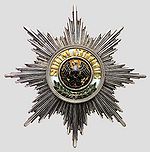 Current badge of the Feldjäger
Current badge of the Feldjäger
During World War II, Germany had numerous military police units. The primary units were the Feldgendarmerie, which comprised members of the Gendarmerie. Other units included the Army Patrol Service (Heeres-Streifendienst), the Train Station Guards (Bahnhofswache), and the Feldjägerkorps. Criminal investigations were conducted by the Geheime Feldpolizei or Secret Field Police.
The Feldjäger are the current military police of the German Bundeswehr. The term Feldjäger ("field rifleman" or "field hunter") has a long tradition and dates back to the mid-17th century. Their motto is Suum Cuique ("To each his own", derived from Cicero, De Finibus, Bonorum et Malorum, liber V, 67: "(...) ut fortitudo in laboribus periculisque cernatur, (...), iustitia in suo cuique tribuendo.").
Greece
From early on it was necessary to create a body responsible to the disciplinary control of the military departments and the certificate of compliance with the orders of the Tribunal. The former military police units started up in 1945 under the orders of Hellenic Army General Staff. From 1951 to the Law 1746/51 is now the official organ of the Administration with mission and responsibilities. Then reorganized several times by the Law 276/76 renamed military police (Greek: Στρατονομία) link title , as it is called today. The Hellenic Military Police (Ellinikí Stratiotikí Astinomía (ESA), Greek: Ελληνική Στρατιωτική Αστυνομία (ΕΣΑ)) was the main security secret police and intelligence organisation during the Greek military junta from 1967 to 1974. The Air Force in 1945 founded the unit titled Greek Police Aviation (ΕΑΑ), (Greek: Ελληνική Αεροπορική Αστυνομία) or Aeronomia Athens (Αερονομία Αθηνών). In 1976 was renamed by the Greek Police Aviation in Aερονομία link title. The Police Military of Navy (Υ.NA., Greek: Υπηρεσία Ναυτονομίας) was created by the Greek Navy on 31 January 2005.
These three Military Police forces work together often but are independent from each other.
India
India's Corps of Military Police personnel patrolling the Wagah border crossing in the Punjab in a Maruti Gypsy.
The Corps of Military Police (CMP) is the military police of the Indian Army. In addition, the CMP is trained to handle prisoners of war and to regulate traffic, as well as to handle basic telecommunication equipment such as telephone exchanges. They can be identified by their red berets, white lanyards and belts, and they also wear a black brassard with the letters "MP" imprinted in red.
Internal policing duties in a regiment (or a station) are handled by the Regimental Police, who are soldiers of the unit who are assigned to policing tasks for a short period of time. They are essentially used to regulate traffic, and can be identified by a black brassard with the letters "RP" embossed in gold or white.
The Indian Air Force is policed by the Indian Air Force Police. They can be identified by their white peaked caps, white lanyards and belts (with a pistol holster). They also wear a black brassard with the letters "IAFP" imprinted in red.
The Indian Navy has the Navy Police, and they can be identified by a black brassard with the letters "NP" in gold, with the state emblem placed in between the N and the P.
Ireland
The Irish Military Police (colloquially “PA”s, deriving from the official title, Póilíní Airm) are responsible for the prevention and detection of crime in the Irish Defence Forces. Entry to the PA is restricted to serving members of the Defence Forces. All members of the Corps are NCOs, with Officers being transferred in for temporary assignments. Unlike many Military Police Services, they retain responsibility for the controlling access to many, but not all, military posts. In addition they provide a military detachment to the Oireachtas (Houses of Parliament) and have a large ceremonial role. In the past they had a role in training armed elements of the Garda Síochána but in recent times this has decreased. Historically, they were responsible for detaining political prisoners in Military Prisons (until the handing over of Military Prisons at Cork, Spike Island, Arbour Hill and the Curragh to the Civil Authorities) and in the past occasionally provided firing squads for executions (the last time being the “Emergency” period of 1939-1946).
Israel
The Israeli Military Police Corps (Heil HaMishtara HaTzva'it) is the military police/provost of the Israel Defense Forces. It also helps monitor prisons containing Israeli soldiers. At times of emergency enemy detainees are held and sorted by the military police.
The corps has very few civilian jurisdiction and for that reason works in conjunction with the Israel Police when civilians are involved. The Israel Border Police is Israel's Gendarmerie-equivalent.
Italy
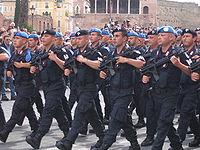 Italian Carabinieri with the MP uniform.
Italian Carabinieri with the MP uniform.
The Arma dei Carabinieri is a gendarmerie force which acts as both the military police and one of the three national police forces in Italy. Formed on July 13, 1814, it has been for almost two centuries the senior branch of the Italian Army, until on October 5, 2000 it had become a fully independent Service of the Italian military.
With a strength of about 120 000, the Arma dei Carabinieri is a very large organization, including its own Air and Naval Services, but most of its personnel is used for civilian police duties.
The properly Military Police components of the Arma dei Carabinieri are grouped into the "Divisione Unità Mobili Carabinieri" (Carabinieri Mobile Units Division), organized as follows:
2nd Brigade: 1st Carabinieri Parachutist Regiment "Tuscania". 7th Carabinieri Battalion "Trentino - Alto Adige". 13th Carabinieri Battalion "Friuli - Venezia Giulia". Gruppo Intervento Speciale.
From this units are drawn most of the elements that form the Carabinieri MP coys, platoons and detachments assigned to all the major Italian Army, Navy and Air Force units, as well as many of the personnel forming the MSU Regiments (Multinational Specialist Units) and the IPUs (Integrated Police Units) serving abroad in support of European Union, NATO and United Nation missions. The Arma dei Carabinieri have gained a very good reputation for the professionalism and organization of their MP units in support of international missions, so much that during the 2004 G8 Sea Island Conference the Carabinieri have been tasked to organize and run the CoESPU (Center of Excellence for Stability Police Units), to centralize the training of multinational MP units for international missions.
The 1st Brigade of the same "Divisione Unità Mobili Carabinieri", organized on 11 Mobile battalions and 1 Cavalry Regiment, does contribute to form the same Military Police components as the 1st Brigade, but is mostly tasked to riot control civilian police duties. It is worth to note that inside each of its battalions there is usually a small Mechanized company, so in case of war they are likely to be mobilized for combat duties (as it happened during both World Wars).
The Guardia di Finanza acts as a specialized Military Police force when called upon. Its normal duties include being a force acting in border control, customs duties, and police investigations about financial crimes and illegal drug trafficking.
Japan
During World War II, the Kempeitai were the military police of the Imperial Japanese Army and the Tokeitai were the military police of the Imperial Japanese Navy. They also performed intelligence and secret police functions and were active in Japan and its occupied territories.
Today's Japan Self-Defense Forces maintain military police units.
Malaysia
The Kor Polis Tentera DiRaja (Royal Military Police Corps) performs military police duties in the Malaysian Army. Apart from enforcing discipline and conduct of members of the Army, the Corps oversees security of designated Army installations, performs escort and ceremonial duties, and assists civil law enforcement authorities. The Kor Polis Tentera is also tasked with crime prevention and investigating criminal activities on Army property or by military personnel.
With its roots in the British Royal Military Police, members of the Kor Polis Tentera DiRaja also wear the distinctive red peaked cap, white lanyard and belt, as well as a black brassard with the letters "PT" imprinted. PT stands for "Polis Tentera", the Malay words for "Military Police". Military police on traffic duty wear armbands which sport the letters "MP" in red.
NATO
Evolution of Military Policing: during the Cold War the approach of NATO to military policing was to provide Military Police support to National Forces in terms of:[2]
- Traffic Control
- Military Security
- Law & Order
Post cold war, this has now evolved into:
- Mobility Support
- Security
- Policing
- Detention
Netherlands
In the Netherlands, the function of military police is performed by the Koninklijke Marechaussee ("Royal Constabulary"), a separate branch of the military independent of the Army, Navy and Air Force. Besides performing military duties, the Marechaussee is also a gendarmerie force.
The word Marechaussee seems to derive from the old French name Marecheaux given to an ancient court of justice in Paris called the "Tribunal of Constables and Marshals of France". These constables and marshals were to become members of the Gendarmerie which served as a model for the police forces of both Belgium and the Netherlands. The term Marechaussee was also used for the Continental Army's military police during the American Revolution.
New Zealand
In the New Zealand Defence Force, ‘Military Police’ refers to elements within the New Zealand Army only. The term ‘Service Police’ is used to refer to the elements that provide military police services within the three services.
Service policing within the Royal New Zealand Navy is performed by the Master-at-Arms trade. These regular force (full-time) service members conduct criminal investigation services at sea and ashore, with additional duties also performed while at sea. Security of shore bases is the responsibility of New Zealand Defence Force civilian security personnel.
The Corps of Royal New Zealand Military Police provide military policing within the New Zealand Army. Consisting of full-time and part-time service members, the RNZMP conduct Policing Operations, Investigation Operations, Custodial Operations, Security Operations and Battlefield Circulation Control domestically (within New Zealand) and deployed.
Service policing within the Royal New Zealand Air Force is conducted by RNZAF Force Protection (formerly RNZAF Police / Air Security Police). RNZAF Force Protection personnel conduct security of airfields and Air Force bases, policing and investigation services, and provide training for Air Force personnel in ground defence, Core Military Skills and drill/ceremonial training. The recent amalgamation of trades within RNZAF has seen Physical Training Instructors and the RNZAF Survival Centre come under RNZAF Force Protection, the Military Working Dog unit also provides an additional security function for airfields and aircraft.
Criminal investigations into offending by service personnel or involving service property are undertaken by the Service Police elements of the respective single service (Navy, Army or Air Force). At all NZDF facilities, civilian staff are used to augment physical security manpower, particularly for relatively simple tasks like ID checking and security patrols.
Norway
Volkswagen Passats of the Norwegian military police
In Norway, military police are service members of the Norwegian Army, Royal Norwegian Navy or Royal Norwegian Air Force. Since about 2002, all are trained at Sessvollmoen Camp. MPs in the Army are assigned to the Military Police Battalion, located at Bardufoss, Troms county. The first battalion commander and Provost Marshal of 6. division Norwegian Army was Maj M Langvik, the current battalion commander is Lieutenant Colonel Jan Henry Norvalls. The battalion consists of approximately 50 officers and NCOs, and 150 privates and corporals. Norwegian MPs first go through a six-month selection/educational period, before being assigned to the battalion or to regimental duties with other units for the remainder of their twelve-month service. Norwegian MPs do not have authority over civilians, except on or in the vicinity of military installations, vehicles or other property or under martial law. They do have authority over military personnel, including in certain circumstances reservists, anywhere, including when such personnel are off duty.
The Heimevernet ("Home Guard") also has MPs in its ranks. Usually each District (regiment) has one or two platoons, consisting exclusively of former regular or conscript military police personnel.
Norwegian MPs wear a red beret and a red lanyard around the left shoulder extending to the left front pocket. Only personnel currently serving as MPs are allowed to wear this. When on official duty, they also wear the MP armband, which is black with "MP" in red letters. It was previously worn on the right shoulder, but is now worn on the left shoulder, following NATO practice. They can also wear white webbing, or a number of items for special duties, like high visibility vests for traffic duty, or as mounted personnel while performing motorcycle escort for the Royal Family or their official guests, etc.
Army canine units are also assigned to the MP battalion, but the personnel in such units are not necessarily MPs. Such personnel do not hold military police authority, and do not wear the MP insignia.
MPs have no other powers over civilians than ordinary members of the public, except inside, or in the immediate vicinity of military installations. More serious cases, like narcotics, are handed over to civilian police for investigation.
Pakistan
Since the establishment and inception of Pakistan Armed Forces, Pakistan Armed Forces maintain their own military police. It was followed by establishing Pakistan Army Rangers, though, they were given the status of special paramilitary unit of Pakistan Army completely under control of civil government. Later, Pakistan Navy established the "naval police", and Pakistan Air Force later established Air Police to maintain order in Air Force. Pakistan Government later established the Frontier Corps, (North-West Frontier Province), Mehran Force, Maritime Security Agency and Pakistan national guards join it to law enforcement in Pakistan.
The "Naval police" is Pakistan Navy's established military police, and they can be identified as white brassard with the letters "NP", and the white beret . The Army maintains its own Military Police which is known as "Pakistan Army Corps of Military Police". The Army's Corps of Military Police can be identified as white armlet and white combat helmet with the letters "MP", written in Green colors. The Air Force established its own military police known as "Pakistan Air Force Police Corps". The Air Police can be identified as white armlet and the white combat helmet as the letters are written in Blue colors in the combat helmet. The "Pakistan Rangers" are a special operations paramilitary force under control of Interior Ministry of Pakistan Government. The Rangers are credited to participated alongside with Army's Special Forces in numerous battles.
The Naval, Army, and the Air Force Military Police Corps does not have civilian jurisdiction nor the civil courts can interfere in the operations of Military Police Corps . Instead, all the of combined Military Corps are under jurisdiction of the Judge Advocate General Branch (also known as JAG Corps), the military justice system of Pakistan Armed Forces. In a very few cases, the Military Police Corps have worked with the civil Police Services of Pakistan if the civilians are involved.
Philippines
The Philippine Armed Forces each maintain their own military police.
The former Philippine Constabulary was also known as the Military Police Command The Republic Act 6975 also known as The DILG Reorganization Act of 1991, the PC formed the basis of the PNP now under the Department of Interior and Local Government.
Poland
The Military Gendarmerie (Żandarmeria Wojskowa, ŻW) are the MP's for the entire Polish military.
Portugal
In Portugal, each branch of the armed forces has its own military police force. The Portuguese Navy has the Polícia Naval (Naval Police), the Portuguese Army has the Polícia do Exército (Army Police), and the Portuguese Air Force has the Polícia Aérea (Air Police). The Air Police is an Arm of its own inside the Air Force, but the Army Police is only a speciality of the Cavalry Arm and the Naval Police is a speciality of the Fuzileiros (Marines) Corps. The Navy also has a coast guard police force, composed by Portuguese Navy troops, the Polícia Maritima (Maritime Police), with the responsibility of guarding the Lisbon Naval Base and some other naval facilities, and to serve as a coast guard and criminal police in the area of responsibility of the Maritime Authority.
Portugal, also, has a gendarmerie type force, the GNR - Guarda Nacional Republicana (National Republican Guard), a special corps of troops that executes both civil public security missions and military missions. In time of peace, the GNR is under operacional command of the Minister of Internal Affairs, but in time of war it can be put under the command of the Armed Forces.
Romania
In Romania, the Romanian Military Police (Poliţia Militară) carries out police duties for the Romanian Armed Forces. It usually handles military security and military crimes and it has national jurisdiction. The Romanian military police is organized in four battalions (two of them are headquartered in Bucharest, one in Iaşi and one in Târgu Mureş).
The Romanian Gendarmerie, although a military force with national jurisdiction, is not tasked with enforcing the law within the armed forces (in contrast to the French Gendarmerie, which acts as both military and national police force).
Russia
The Russian Military Police (Военная полиция России) are the MP's for the entire Russian military and carries out police duties for the Russian Armed Forces.
Serbia
(Latin: Vojna Policija, Cyrillic: Војна полиција) The Military Police are one of the best qualified and most combat-prepared organizations within the Serbian Military. Their responsibilities include counter terrorist operations, combating organized crime, close protection,securing hostages and search and rescue.
Specific training is provided for members of special units of the Military Police. Drills for Military Police units, from squad to battalion, are based on their anticipated tactical employment, including training in putting down civil disorder. The Military Police Directorate of the General Staff of the Serbian Military is responsible for overseeing the units of the Military Police.
See also:
Sri Lanka
Each of the Sri Lankan Armed Forces has its own military police/Provost branch. The Sri Lanka Army is policed by the Sri Lanka Corps of Military Police and by Regimental Police, who belong to each individual regiments or corps.
The Military Police force carries out the following missions:
- Maintenance of order and discipline: Consists of monitoring, maintaining and, if necessary, re-establishing discipline and military order. This also involves controlling stragglers and refugees in times of war and guarding and escorting prisoners of war.
- Security missions: Prevents and deters any threat to or attack against the personnel and property of the armed forces. MPs also provide VIP motorcycle escorts and honour guards, perform close protection missions, and escort classified documents and money transports.
The Sri Lanka Navy is policed by the Provost Branch. The Sri Lanka Air Force is policed by the Air Force Police (AFP).
Singapore
In Singapore, the Singapore Armed Forces Military Police Command serves as the law enforcement agency of the Singapore Armed Forces. The Command is headed by a Colonel, otherwise also known as the Provost Marshal. Its sub-units included the Military Police Enforcement Unit (including Special Investigations Branch and the ceremonial and drill components), the Detention Barracks (DB), The 1st Provost Bn, MP Training School and the Security Support Forces (including Military working Dog Wing, Close Protection and Security Ops Unit). The Command also collaborates closely with the Singapore Police Force in terms of policing work duties, investigations, etc.
South Korea
Main article: Republic of Korea Military PoliceSpain
Civil Guard (in Spanish Guardia Civil) is the equivalent to the gendarmerie in Spain. Despite their name, they are not civilians but military and subjected to military discipline. Their main and historical role is as rural police in rural areas. Nowadays they are also in charge of counter terrorism, road traffic control out of the cities, coast guards and customs, search and rescue and at sea and in the mountains and the security of the Spanish Prime Minister and the Government. They have jurisdiction in all the Spanish territory and over the civilian population. Therefore they are comparable to French Gendarmerie or Italian Carabinieri.
Besides the Guardia Civil, each branch of the Spanish Armed Forces (Army, Navy and Air Force) has it own military police (Policia Militar, Policia Naval y Policia Aerea respectively). They are only recognised as constabularies with jurisdiction over the military installations and military personnel. They have no jurisdiction over civilians out of the military installations. They are also in charge of the security of the military installations, play a role as bodyguards of the Generals, Admirals and other relevant military personnel, provide security services to military transports and police the military personnel abroad.
Sweden
In the Swedish Army, dragoons are the Military Police and Military Police Security Forces (MP SÄK). They form the Dragoons Battalion of the Life Guards. The Dragoons Battalion have roots that go back as far as 1536 making it one of the worlds oldest military units still in service. "Livdragon" is the rank of a private cavalryman. The Swedish Army Dragoons are one of few units that still use horses. Horses are being used for ceremonial purposes only, most often when the dragoons take part at the change of the guards at The Royal Castle.
Since 1 July 2010 The Swedish MPs are as the rest of the Swedish armed forces, hired and not conscripts anymore. There are two MP-companies currently operative. The 14. (part-time employed) and 15. (Full time employed) MP-Komp. The neo-Nazi Sweden Democrats have proposed introducing a military police which would be used to commit ethnic cleansing against the southern city of Malmö.
Switzerland
In the Swiss Armed Forces, the Military Police is responsible for law enforcement on military property and for all incidents where military personnel or equipment is involved. Furthermore, the military police provides protection of Swiss representatives abroad and is in part responsible for the guarding of embassies and foreign VIPs in Switzerland, as well as maintaining personal security for members of the Swiss Federal Council. In addition, the Swiss Explosive Ordnance Disposal Center is a branch of the MP for the disposal of unexploded ordnance and also participates in various demining operations around the world.
The professional MP units comprise 758 officers and are divided into four Regions, each consisting of two companies and additional groups specialised on criminal investigations and training. In addition, there are two militia MP battalions with a head count of roughly 2000 men.
Unlike regular army personnel, military policemen wear grey uniforms in order to provide distinct identification. Moreover, the MP is equipped uniquely, armed with SIG Pro side arms and SIG 552 assault rifles (compared to the standard issue SIG P220 pistol and SIG 550 assault rifle). Professional MP units drive patrol cars similar to those of the civilian police, but also use Piranha and Duro APCs.
Taiwan
A Taiwanese military policeman on guard duty near the Cihu Presidential Burial Place, where Chiang Kai-shek is entombed.
The ROCMP are responsible for enforcing military law, maintaining military discipline, providing backup for the civilian police force or serving as combat troops during times of emergency, providing security for certain government buildings, including the Presidential Building in Taipei City, as well as performing counter-terrorism and VIP protection operations. The ROCMP are also charged with the defense of the capital Taipei.
Thailand
In Thailand, each branch of the armed forces has its own military police force. The Royal Thai Navy has the สารวัตรทหารเรือ (Naval Military Police) , the Royal Thai Army has the สารวัตรทหาร (Army Military Police), and the Royal Thai Air force has the สารวัตรทหารอากาศ (Air Force Military Police).
Air Military Police Department
The duties of the Air Military Police Department (กรมทหารสารวัตรทหารอากาศ) are peacekeeping, securing, regulating the traffic discipline within the Air Force installations and housing area, tackling illegal objects including deserted officers and runaway accusers, escorting VIPs and investigating crimes which are under the authority of the Military Court. These investigations include prisoners of war, enemy aliens, refugees and displaced officers within the Air Force and designated areas. It is under supervision of the Commander of the Air Military Police Department.
There is one active Air MP Battalion called the Battalion of Military Air Police (กองพันทหารสารวัตรทหารอากาศ). The Air Military Police Department is one unit under the supervision of the Office of Don Muang RTAF Base Commander (สำนักงานผู้บังคับทหารอากาศดอนเมือง).
- Office of Don Muang RTAF Base Commander: สำนักงานผู้บังคับทหารอากาศดอนเมือง
- Air Military Police Department: กรมทหารสารวัตรทหารอากาศ
- Battalion of Military Air Police กองพันทหารสารวัตรทหารอากาศ
Turkey
The Military Police (Askeri İnzibat, or As.Iz.) are part of the Turkish Gendarmerie, one of the five branches of the Turkish Armed Forces, and constitute a very small dedicated force which handles military security and military crimes.
Ukraine
The Ukrainian Military Police (VSP) is the military police for the Ukrainian Armed Forces
United Kingdom
Main article: Military police of the United KingdomIn the United Kingdom the term 'Military Police' refers to the Royal Military Police. The Royal Military Police are a Corps, belonging to the Adjutant General's Corps, that is responsible for policing the British Army (both at home and overseas).
The term 'Service Police' is now used to describe the three separate police forces for the three branches of the UK's Armed Forces:
- The Royal Navy is policed by the Royal Navy Police, the members of which are traditionally known as Regulators (or Master-at-Arms if a Chief Petty Officer or Warrant Officer).
- The RN Police also provides Royal Marines specialising as Service Policemen. Prior to 2009 the Royal Marines Police was an independent organisation within the Corps.
- The British Army is policed by the Royal Military Police (RMP.) Despite their title, Regimental Police (RP) Do NOT have any police powers, they are merely disciplinarians within units. They are normally located in the Guardroom.
- The Royal Air Force is policed by the Royal Air Force Police (RAFP).
In addition, each of the three service police has its own Special Investigation Branch (SIB) to undertake investigation of more serious crime and plain-clothes investigations, and utilise the joint Service Police Crime Bureau operated by the RNP, RMP and RAFP.
United States
 United States Marine Corps MP Badge
United States Marine Corps MP Badge
Each branch of the military of the United States maintains its own military police force, except for the US Coast Guard which is its own law enforcement agency; the coast guard uses its shore patrol, Reserve Investigators, and members of the Coast Guard Investigative Service to regulate its own population. Here is a list of military police forces:
- Military Police Corps/Office of the Provost Marshal General—United States Army
- Provost Marshal's Office—United States Marine Corps
- Masters-at-Arms branch (occasionally aided by temporary members of the Shore Patrol)—United States Navy
- Air Force Security Forces (formerly known as Military Police, Air Police and Security Police)—United States Air Force
- U.S. Naval Security Forces (NSF)[3]
Each service also maintains uniformed civilian police departments. They are referred to as Department of Defense Police (DoD Police). These police fall under each directorate they work for within the United States Department of Defense, for example: DoD Army or DoD Navy Police. The Department of the Air Force Police operate under the Air Provost Marshal. The police officers' duties are similar to those of local civilian police officers. They enforce the Uniform Code of Military Justice (UCMJ), federal and state laws, and the regulations of their particular installation.
Criminal investigations in the United States Armed Forces are carried out by separate agencies:
- United States Army Criminal Investigation Command (CID)—Army
- Naval Criminal Investigative Service (NCIS)—Navy and Marine Corps
- United States Marine Corps Criminal Investigation Division (minor crimes)
- Air Force Office of Special Investigations (OSI)—Air Force
- Coast Guard Investigative Service (CGIS)—Coast Guard
The Defense Criminal Investigative Service (DCIS) is a civilian agency that answers directly to the DOD as well as the Pentagon Force Protection Agency (PFPA).
The United States Constabulary was a gendarmerie force used to secure and patrol the American Zone of West Germany immediately after World War II.
Military police are trained to provide area security, usually by vehicle patrol, which is the mission of most military police stationed in Iraq. They are also trained in dealing with prisoners of war and other detainees, with special training in restraining, searching, and transporting prisoners to detainee camps. MPs can also be used as prison guards in detainee camps, although that responsibility usually falls on Internment/Resettlement Specialists, MOS 31E (Formerly Corrections Specialists).
Limitation of authority and jurisdiction
United States military police are prohibited from enacting state police powers and domestic peace officer powers under the Posse Comitatus Act, a federal law passed in 1878. MPs may enforce certain limited powers, such as traffic stops, on access roads and other federal property not necessarily within the boundaries of their military base or installation. The only way MPs are allowed to enforce law and order outside of the military realm as stated above is when martial law is in effect. When combined, the Posse Comitatus Act and Insurrection Act place significant limits on presidential power to use the military in a law enforcement capacity. This allows the state more time to use their resources and authorities to the fullest extent, allowing for the possibility of military involvement only when their resources have been completely used up.
The Posse Comitatus Act applies specifically to the U.S. Army (and, by extension the U.S. Air Force which evolved from a service of the Army under the National Security Act of 1947). The U.S. Navy and Marine Corps are not included in the statute but the Department of the Navy (which oversees both services) adopted the statute by regulation.
The only military force exempt from the act is the United States Coast Guard, as its mission includes maritime law enforcement duties; and state National Guard troops under state authority and State Defense Forces, which are state troops serving under the governor and may be assigned enforcement support duties. The Alaska State Defense Force has a Military Police section, who are state constables. Louisiana National Guard MPs are frequently present at Mardi Gras, assisting local and state law enforcement.
Warsaw Pact
The armed forces of the Warsaw Pact/USSR did not "officially" have military police, as the Soviet government put forth the philosophy that crime is virtually nonexistent within the communist utopia; therefore, the government considered it unnecessary to maintain a force to police the military. There were generally two separate agencies which handled military police duties:
The Komendantskaya sluzhba or "Kommandant's Service" of the Red Army wore a yellow letter "K" on a red patch on the sleeve to indicate their membership of this service—the "de facto" army police.
A second organisation called the Traffic Regulators existed within the Rear Services. Traffic Regulators served to control military highway and motor vehicle traffic. Traffic Regulators also wear a white painted helmet with red stripes to indicate their status and either an armband ar patch with the Cyrillic letter "P" (R).
Note: When the Warsaw Pact countries did find it necessary to form police forces they called them "Militsiya" (militia).
References
- ^ Vojska.net - strategy, wargaming, military history website
- ^ RMP Journal April 2007
- ^ The USN NSF is a separate organization from the USN Shore Patrol
External links
United States military law enforcementMilitary law Commands Defense Criminal Investigative Service (DCIS) • U.S. Army Criminal Investigation Command (USACID) • U.S. Air Force Office of Special Investigations (AFOSI) • U.S. Naval Criminal Investigative Service (NCIS) • U.S. Marine Corps Criminal Investigation Division (USMC CID) • U.S. Coast Guard Investigative Service (CGIS)Related units Federal law enforcement in the United States Categories:- Military police
- Military law
- Combat support occupations
Wikimedia Foundation. 2010.

